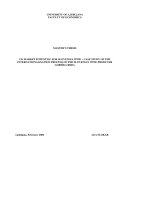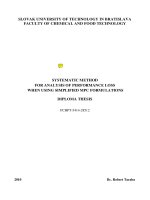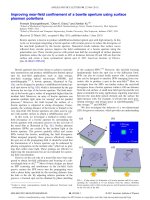Manufacturing process of car spoiler product using continuous rattan fiber composite materials
Bạn đang xem bản rút gọn của tài liệu. Xem và tải ngay bản đầy đủ của tài liệu tại đây (380.91 KB, 7 trang )
International Journal of Mechanical Engineering and Technology (IJMET)
Volume 11, Issue 1, January 2020, pp. 9-15, Article ID: IJMET_11_01_002
Available online at />ISSN Print: 0976-6340 and ISSN Online: 0976-6359
© IAEME Publication
MANUFACTURING PROCESS OF CAR
SPOILER PRODUCT USING CONTINUOUS
RATTAN FIBER COMPOSITE MATERIALS
Agustinus Purna Irawan, Adianto and I Wayan Sukania
Department of Mechanical Engineering, Faculty of Engineering,
Universitas Tarumanagara, Jakarta, Indonesia
ABSTRACT
This study aims to develop the process of manufacturing car spoiler products
using continuous rattan fiber composite materials. Rattan fiber was chosen because of
its good strength, abundant availability in Indonesia and inexpensive price. The study
was conducted by testing the strength of a composite rattan fiber, simulation using
computer software, comparing with pre-existing spoilers and making prototypes of
spoilers. Based on the results of the study, the strength of continuous rattan fiber
composite materials with polymer matrix is as follows: maximum tensile strength of 27
MPa, maximum compressive strength of 44 MPa, maximum flexural strength of 46
MPa, and maximum impact strength of 29 kJ/m2. As a comparison, ABS plastic
material used in many car spoilers has a maximum tensile strength of 35 MPa, a
maximum compressive strength of 48 MPa, a maximum flexural strength of 56 MPa,
and a maximum impact strength of 31 kJ/m2. From the results of the simulation of
loading using software carried out on the composite material of polymer rattan fibers,
we obtain a compressive strength of 2000 N load of 51 MPa with compressive strain
of 0.00873 mm/mm. From the results of simulation loading using software carried out
on ABS plastic material, we obtain a compressive strength for the 20110 N load of 48
MPa. The manufacturing process has produced a prototype of spoilers that are ready
to use with good results. The results of this study will be a reference for the next
development.
Keywords: Rattan fiber, composites, manufacturing, car spoiler.
Cite this Article: Agustinus Purna Irawan, Adianto and I Wayan Sukania,
Manufacturing Process of Car Spoiler Product Using Continuous Rattan Fiber
Composite Materials. International Journal of Mechanical Engineering and
Technology 11(1), 2020, pp. 9-15.
/>
1. INTRODUCTION
The development of composite technology has now begun to experience a shift from synthetic
fiber-reinforced composite materials to natural fiber-reinforced composite materials [1], [2].
This technological trend shift is based on the nature of the composite reinforced natural fibers
that are more environmentally friendly, are widely available in nature, can be recycled and are
/>
9
Agustinus Purna Irawan, Adianto and I Wayan Sukania
relatively cheap [3]. This composite also has a high strength of density ratio so that the
resulting component is lighter [4], [5]. The researchers used natural fiber composites as
superior products according to their features. Although it does not completely replace
synthetic fibers, the use of environmentally friendly natural fibers is a wise step to maintain
environmental sustainability. Maya et al [6] conducted a review of natural fibers and bio
composites. The result obtained is that natural fibers produce good interfacial interactions
with resin as a matrix. Based on this research, a biomaterial consisted of ramie, bamboo and
rattan fiber composites with a resin matrix is developed. Some natural fibers such as ramie
fiber, bamboo, and rattan fibers have better mechanical characteristics compared to fiberglass,
for instance, having higher elastic modulus, lower density, and lighter weight than fiberglass.
However, the specific strength of those natural fibers approaches the specific strength value of
fiberglass [6] - [8].
The potential of Indonesia's natural fiber is very abundant with various types of fibers that
have good strength, but until now it has not been utilized optimally for the improvement of
people's welfare. One of Indonesia's natural fiber potentials is rattan which has various types
and qualities. Various types of good quality rattan thrive in various regions in Indonesia,
especially on the islands of Kalimantan and Sumatera. Rattan fiber has good potential to be
developed into bio composite materials that are environmentally friendly, inexpensive, strong,
recyclable and renewable. Rattan fiber is produced in Indonesia’s nature and is used as
furniture [9] - [12].
Rattan fiber has the potential to be further developed to produce higher-value products
such as automotive components. Until now, the development of rattan fiber-based products,
especially in developing automotive products, has not been done much by researchers.
2. METHOD
2.1. Material Preparation
Rattan fiber composite material is produced by making rattan fiber swing from continuous
rattan. The size of the rattan fiber as follows width: 2.5 mm, thickness 1.5 mm and length 300
mm. Rattan woven fiber is made in the direction of 0 degrees and 90 degrees, made not too
tightly with the aim that the epoxy resin can get inside between the fibers so that it can bind
the fibers well. The lamination process is carried out by pouring epoxy resin into the fiber,
then a compressive process is carried out so that the resin can enter the fiber properly. This
process is carried out in an epoxy rattan fiber composite mold [1], [2].
2.2. Strength Testing
Mechanical strength testing includes tensile strength ASTM D 3039/D3039M, compressive
strength ASTM D 695, flexural strength ASTM D 730-03, impact test ISO 179:97, and
morphological analysis using Scanning Electron Microscope (SEM). Comparative data from
the strength of rattan fiber composite materials, obtained by testing the strength of ABS
plastic materials and simulations using computer software [1], [2].
2.3. Spoiler Prototype Manufacturing Process
The making of car spoiler prototypes is done with a scale of 1:1 in the form of spoiler
products for Innova and Fortuner cars. Prototyping was carried out in a workshop in
collaboration with Small and Medium Enterprises that have been accustomed to making car
spoilers from glass fiber material with a resin matrix.
/>
10
Manufacturing Process of Car Spoiler Product Using Continuous Rattan Fiber Composite
Materials
3. RESULTS AND DISCUSSIONS
3.1. Mechanical Characteristics of Materials
The research began by making mechanical strength test samples from continuous rattan fiber
composite materials including tensile strength, compressive strength, flexural strength, and
impact strength. The test results are compared with the strength of the spoiler products made
from ABS plastic material. The data is also validated by simulations using computer software.
The next step is to carry out morphological observations of continuous rattan fiber composite
samples and ABS plastic. The data obtained were compared and analyzed, so that conclusions
can be drawn on the potential of rattan fiber composites as car spoiler material.
The strength of spoiler products made from continuous rattan fiber composite materials
with the polymer matrix and spoiler products made from ABS plastic material is shown in
Table 1.
Table 1. The test result of mechanical characteristics of materials [1], [2]
No.
1.
2.
3.
4.
ABS plastic
material
35
48
56
31
Mechanical characteristics
Tensile strength (MPa)
Compressive strength (MPa)
Flexural strength (MPa)
Impact strength (kJ/m2)
Continuous rattan fiber
composite material
27
44
46
29
Based on the test results (Table 1), the biggest difference in tensile testing results is 22.8%
and the smallest difference in impact testing is 4.3%. The difference in overall average test
results of 13.6% is still in a good value range. The biggest difference in tensile testing occurs
due to the improper selection of test samples. The greatest tensile strength in the test is in the
direction of the fiber. The greatest flexural strength of continuous fiber composites is obtained
if the test is done perpendicular to the direction of the fiber. The selection of test samples is
very important to produce good tensile and flexural strength. The difference in compressive
strength is 8.8% and the difference in impact strength is 4.3%. These results are very good
and have the potential to be improved by a good composite manufacturing process. In this
study, the focus of the strength to be achieved is the compressive strength of the spoiler
material because it is related to the compressive force of the fastening bolts on the spoiler.
Impact strength is also needed so that spoilers are not easily damaged in the event of a
collision or vibration due to uneven road conditions. Continuous rattan fiber composites have
good compressive and impact strength with a small difference in strength compared to
spoilers made of ABS plastic [13], [14], [16].
From the loading simulation using software carried out on ABS plastic material, we obtain
compressive strength for the 2000 N load of 44 MPa with a compressive strain of 0.01851
mm/mm (Figure 1). The difference in compressive strength of ABS plastic materials with
rattan fiber composite materials and modeling results is 8.3% (Table 2). These results are very
good and can be continued for the development of the spoiler product prototype
manufacturing process using epoxy rattan fiber composite materials.
Table 2. The comparison of compressive strength of spoiler materials
Mechanical characteristics
ABS plastic
material
Compressive strength (MPa)
/>
48
11
Continuous rattan
fiber composite
material
44
Loading
Simulation
44
Agustinus Purna Irawan, Adianto and I Wayan Sukania
Figure 1 compressive loading simulation of spoiler material (2000 N) [1], [2]
If seen from the Scanning Electron Microscope (SEM) test results (Figure 2), it can be
concluded that spoiler products with ABS plastic material only slightly experience voids.
Thus it can be said that the manufacturing process carried out is good so that it produces good
strength as well. In SEM testing of composite materials of epoxy rattan fiber, there are still
many voids and the interface between the fiber and the matrix is still not good. This is what
causes the power generated is still not optimal. Improvement of the manufacturing process of
spoilers made from continuous rattan fiber composites can produce products with better
strength [15], [16].
a. SEM of rattan fiber composite
b. SEM of ABS plastic material
Figure 2 Morphology test using SEM 1000x [1], [2]
3.2. Manufacturing Process of Spoiler Product
The manufacturing process of car spoiler products based on continuous rattan fiber
composites with a polymer matrix consisting of the following steps: making woven fiber
rattan with fiber orientation 00 and 900, thickness 2 ± 0.3 mm and width 4 ± 0.2 mm, size
woven rattan fiber made with a length of 220 cm and width of 70 cm, then soaked in 90%
alcoholic liquid for 30 minutes and then dried. The next step is the manufacturing process by
making a positive mold consisting of 2 parts, namely the top and bottom which both can be
put together to form a spoiler product printed in it. If the positive print is ready, then a mirror
grase is given on the inside of the upper print or the bottom mold so it is not sticky and the
spoiler product can be easily removed from the mold. Mirror grase is the first layer of spoilers
and continued with a continuous layer of rattan fiber, then laminated using a resin matrix and
then tightly closed until it dries. The next step is to open the positive mold and remove the
spoilers from the positive mold, finishing the spoilers so that they are ready to use (Figure 3)
[1], [2], [17], [18].
/>
12
Manufacturing Process of Car Spoiler Product Using Continuous Rattan Fiber Composite
Materials
a. Preparation of rattan fibers and positive molds
b. Manufacturing process of car spoiler
c. Product prototype of spoiler
Figure 3 Manufacturing process of car spoiler using rattan fiber composite
The process of developing a car spoiler product using rattan fiber composite materials has
succeeded in making a prototype of a car spoiler product that is ready for use. Based on the
research that has been done and the manufacturing process of car spoilers, it can be concluded
that continuous rattan fiber in the form of weaving can be used as a raw material for making
spoilers. However, from the prototype of the spoiler product that has been successfully
developed, it is necessary to test and develop the best production process methods so that the
product is strong and able to meet the aesthetic element, therefore they can be used by
consumers as accessory products installed in cars and sold to the market (Figure 4) [1], [2],
[19] - [21].
Figure 4 Product prototyping of car spoiler using rattan fiber composite
/>
13
Agustinus Purna Irawan, Adianto and I Wayan Sukania
4. CONCLUSION
Biomaterial research using rattan fibers with the epoxy matrix as an alternative material to
make car spoilers has been successfully carried out well. The developed biomaterial is
projected to replace synthetic fiber composite materials and ABS plastic. The tensile,
compressive, flexural, and impact strength of epoxy rattan fiber composites produced is very
good when compared to ABS plastic and simulation using computer software. The results of
morphological analysis using SEM on epoxy rattan fiber composites showed a good bond
between the fiber and the matrix. The voids that occur are seen only in small amounts. The
results obtained are supported by a good spoiler prototype fabrication process, thereby
reducing the number of voids. The making of the spoiler prototype shows that it has produced
spoilers that are ready to be used. All of the results of this study will be a reference for further
research in the development of automotive component products using natural fiber composites
that are strong, inexpensive, recyclable, renewable and have abundant potential in Indonesia.
REFERENCES
[1]
Irawan, A. P., Adianto, Sukania, I. W. Flexural strength of car spoiler materials made
from rattan fiber composites. IOP Conference Series: Materials Science and Engineering,
420, 2018, pp. 1-5
[2]
Irawan, A. P., Daywin, F. J., Fanando, and Agustino, T. Mechanical characteristics of
rattan reinforced fiberglass and epoxy composites for shank prosthesis application.
International Journal of Engineering and Technology, 8, 2016, pp. 1543-1550
[3]
Irawan, A. P. Failure Mode Analysis of ramie fiber reinforced composite material. IOP
Conference Series: Materials Science and Engineering, 420, 2018, pp. 1-8
[4]
Mueller D. H., and Krobjilowski, A. New discovery in the properties of composites
reinforced with natural fiber. Journal of Industrial Textiles, 33, 2003, pp. 111-130.
[5]
Irawan, A. P., Soemardi, P. S., Widjajalaksmi K., and Reksoprodjo, A. H. S. Tensile and
flexural strength of ramie fiber reinforced epoxy composites for socket prosthesis
application. International Journal of Mechanical and Material Engineering, 6, 2011, pp.
46-50
[6]
Jacob, M., Francis, B., Thomas, S., and Varughese, K. T. Dynamical mechanical analysis
of sisal/oil palm hybrid fiber-reinforced natural rubber composites. Polymer Composites,
27, 2006, pp. 671-680.
[7]
Irawan, A. P., Soemardi, P. S., Widjajalaksmi K., and Reksoprodjo, A. H. S. Gait analysis
of the prosthesis prototype made from the natural fiber reinforced composite. Proceedings
- Apchi-Ergofuture 2010, pp. 37-43
[8]
Biagiotti, J., Puglia, D., Torre, L., and Kenny, J. M. A systematic investigation on the
influence of the chemical treatment of natural fibers on the properties of their polymer matrix
composites. Polymer Composites, 25, 2004, pp. 470-479.
[9]
Irawan, A. P., Fediyanto, and Tandi, S. The design of bicycle for disable with ergonomic
aspect consideration. Proceedings - Ergo Future 2006, pp. 337-341
[10]
Irawan, A. P., Halim, A. and Kurniawan, H. Hybrid robot climbing system design. IOP
Conference Series: Materials Science and Engineering, 237, 2017, pp. 1-8
[11]
Irawan, A. P., Utama, D. W., Affandi, E., and Suteja, H. Product design of chairless chair
based on local components to provide support for active workers. IOP Conference Series:
Materials Science and Engineering, 508, 2019, pp. 1-6
/>
14
Manufacturing Process of Car Spoiler Product Using Continuous Rattan Fiber Composite
Materials
[12]
Marizar, E. S., Irawan, A. P., and Beng, T. J. The knock down system of rattan furniture
for global market. IOP Conference Series: Materials Science and Engineering, 508, 2019,
pp. 1-5
[13]
Kaczmar, J. W., Pach, J., and Kozlowski, R. Use of natural fibres as fillers for polymer
composites. International Polymer Science and Technology, 34, 2007, pp. T/45-T/50
[14]
Ling-Ping, H., Yong, T., and Lu-Lin, W. Study on ramie, bambu, dan rotane fiber
reinforced polypropylene composite (RF-PP) and its mechanical properties. Advanced
Materials Research, 41, 2008, pp. 313-316
[15]
Torres F. G., and Diaz, R. M. Morphological characterisation of natural fibre reinforced
thermoplastics (NFRTP) processed by extrusion, compression and rotational molding.
Polymers & Polymer Composites, 12, 2004, pp. 705-718
[16]
Rachchha, N. V., Ujeniyab, P. S. and Misrac, R. K. Mechanical characterisation of rattan
fibre polyester composite. Procedia Materials Science, 6, 2014, pp. 1396 – 1404
[17]
Khuong, T. L., Gang, Z., Farid, M., Yu, R., Sun, Z. Z., and Rizwan, M. Tensile strength
and flexural strength testing of acrylonitrile butadiene styrene (ABS) materials for
biomimetic robotic applications. Journal of Biomimetics, Biomaterials and Biomedical
Engineering, 20, 2014, pp. 11-21
[18]
Vácha, J., and Borůvka, M. Mechanical properties of acrylonitrile butadiene styrene
thermoplastic polymer matrix with carbon nanotubes. Nanocon, 2015.
[19]
Vishwakarma, S. K., Pandey, P. and Gupta, N. K. Characterization of ABS material: a
review. Journal of Research in Mechanical Engineering, 3, 2017, pp. 13-16
[20]
Kumar, M. V. S., Rao, B. A., and Mallaiah, G. Design, analysis and manufacturing of a
car rear spoiler for drag reduction. International Advanced Research Journal in Science,
Engineering and Technology, 4, 2017, pp 89-96
[21]
Hamut, H. S., El-Emam, R. S., Aydin, M., and Dincer, I. Effects of rear spoilers on
ground vehicle aerodynamic drag. International Journal of Numerical Methods for Heat
& Fluid Flow, 24, 2014, pp. 627-642
/>
15









